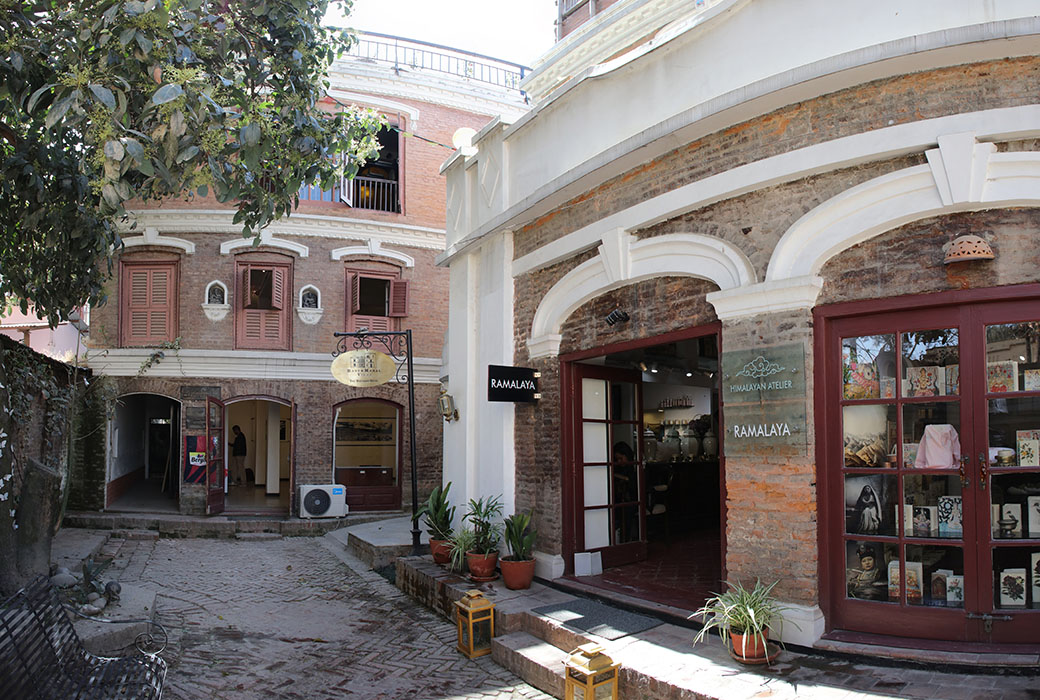

Kathmandu's Siddhartha Art Gallery in the Babar Mahal is the top visual arts venue in Nepal, so I was very proud to show there. I got a couple of great reviews in the national English language press, What the Eyes Can't See in the Kathmandu Post and Capturing an Invisible Reality in the Nepali Times and there was even a children's TV show shot in and about the exhibit! More than that the show was the vehicle for my meeting some amazing Nepali photographers, artists, and art lovers. My thanks to gallerista fantastica Sangeeta Thapa and her crew.
What follows is a virtual recreation of the show, in the order the pictures were hung on the two floors of the gallery.
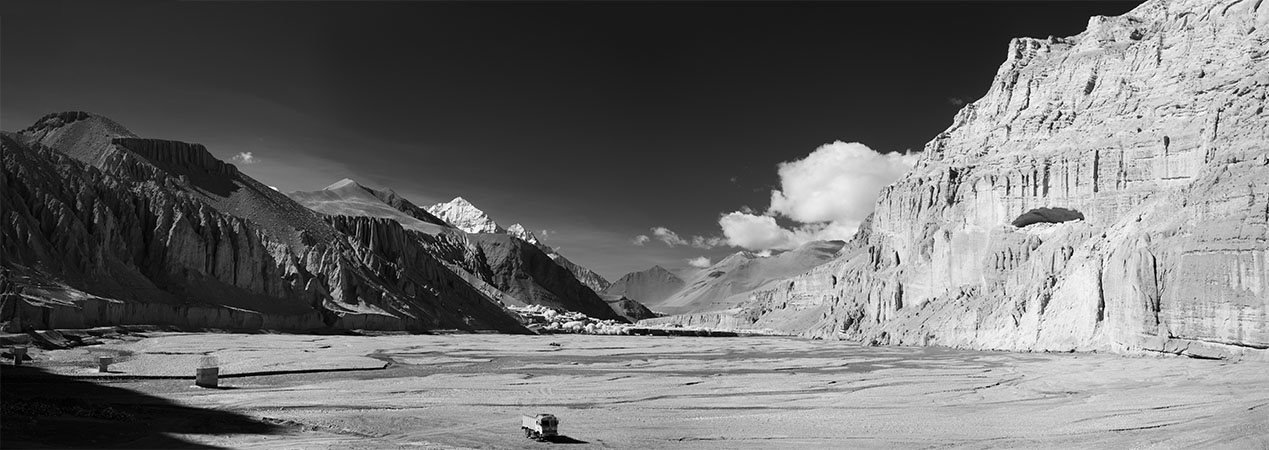
Chhuksang Valley A number of the pictures in this show came out of a single trek, my retirement trip to Upper Mustang (for non-Nepalis it's pronounced "Moose-tang") a semi-autonimous kingdom within Nepal, north of Pokhara and hard against the border with Tibet. Not easy travel, and one of the parts of Nepal that requires a special trekking license. There is now a road from Pokhara to Lo Man Tang, the capital of the kingdom, but it's very new, suitable only for all wheel drive, and very dusty. The canny trekker will take the paths to one side or the other, especially as a person on foot can climb up and cross the saddles of the hills where a vehicle road has to wind it's way around the shoulders of the hills on the sides of the river valleys. And, heading north from the town of Chuksang one has to cross the river bed itself. The little truck in the middle is one of the big all wheel drive Indian goods trucks with six foot tires that are a feature in this part of the world. It's broken down and was still there when we came down the mountain a few days later, joined then by a companion truck stuck in the middle of the river.
Most of the pictures I like from this trip are infrared images like this one, which is a three frame stitched panorama. This is big landscape, and panoramic photography suits it.
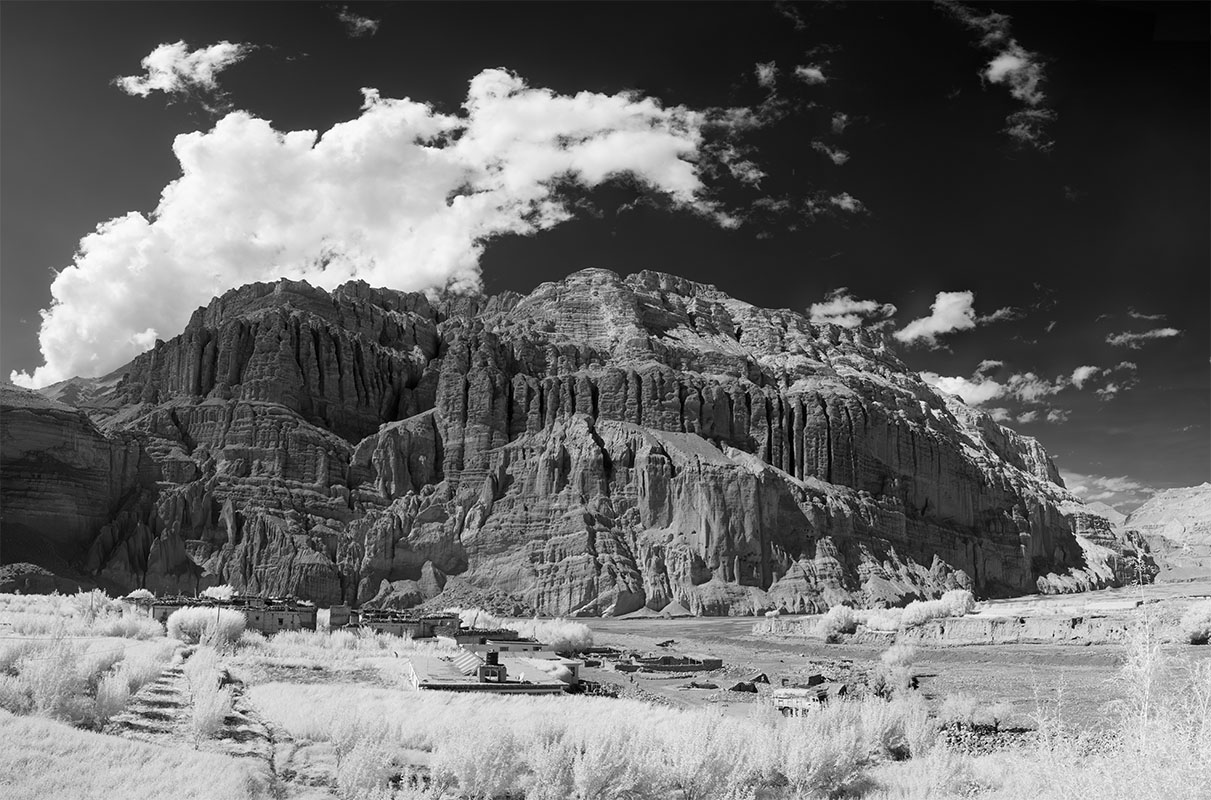
Cliffs at Chhuksang This is a six frame panoramic view across and a bit up the valley from Chhuksang village. (The previous picture is from the top of the valley, looking down.) For an American, Mustang is also interesting for being very like the American Southwest. The region is oddly familiar, and if it weren't for the roadside stupas and Tibetan architecture one can easily imagine Gary Cooper or Clint Eastwood riding by on a big horse.
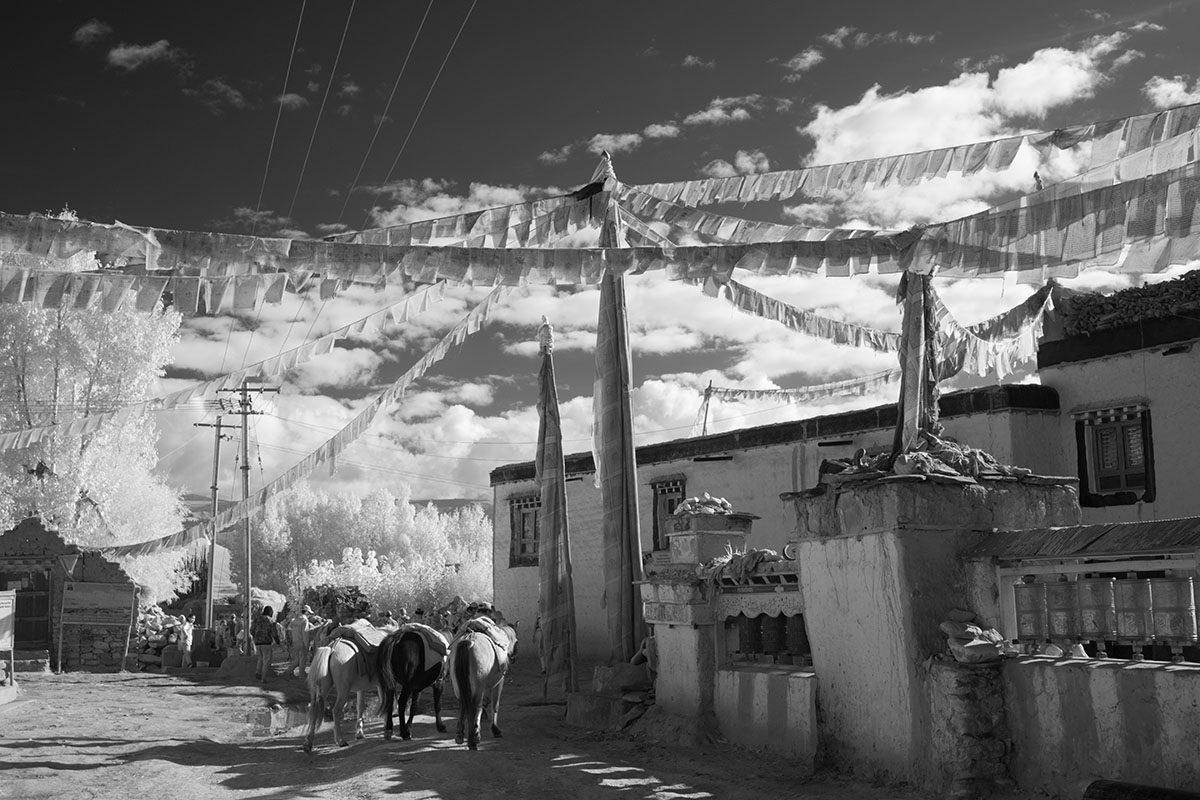
Horses, Lo Mang Tang There are plenty of horses, but they're little Tibetan ponies, used for transporting goods and for transporting tourists, in this case from Lo Mang Tang further up the valley to the caves at Chhoser. I found these little horses very uncomfortable and walked back! Here they're being driven through the streets of Lo Mang Tang to meet up with their load of tourists at the trailhead. Lo Mang Tang is intensely photogenic, and you have great morning light here.

Paro Valley, Bhutan Another big Himalayan landscape in the Kingdom of Bhutan. I have a gallery page for the photos that I took on my trip to Bhutan. This is the view from Paro Dzong, more properly known as Rinpung Dzong showing the whole middle valley. It's nearly a full 180 degrees wide, made up of ten individual photographs. The print is over eight feet wide. It dominated the wall facing the entrance to the gallery.
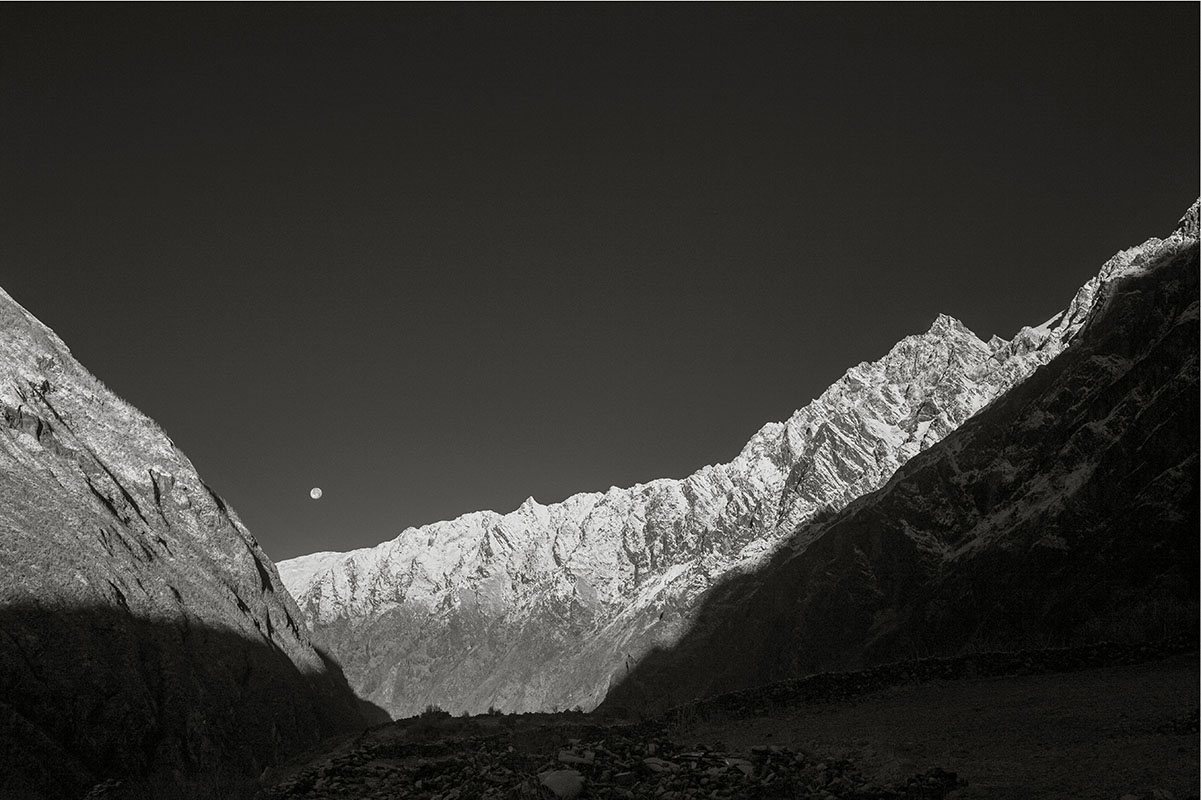
Moonset, Langtang Valley This picture and the next one were taken on my consular business trek to the memorial on the first anniversary of the April 2015 Earthquake. Langtang was very badly affected by that disaster and hundreds were killed by the avalanche that overtook Langtang Village, including tourist from a number of different countries. The valley starts west, and climbs over ten thousand feet to the east from the bottom to the top. This picture was taken very early in the morning looking down and west. The moon is setting, while the rising sun illuminated the tops of the surrounding mountains, leaving the valley floor in shadow.
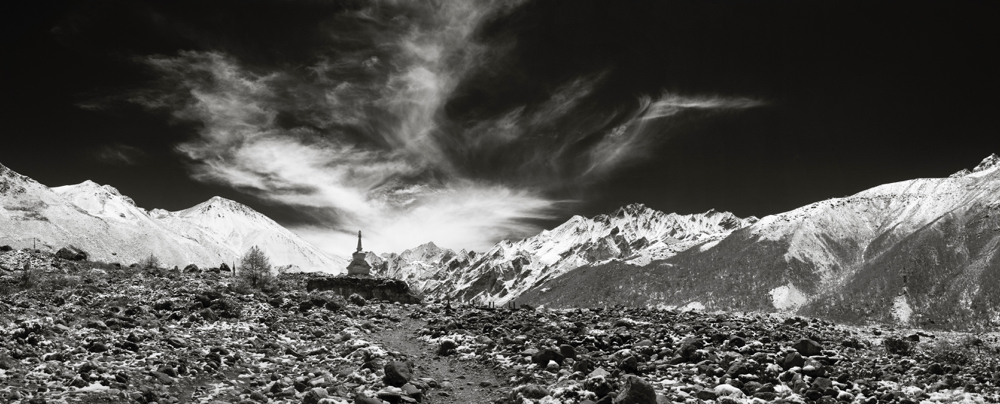
Stupa, Langtang Valley Approaching the top of the valley, looking east. It took two and a half day's walk to get to the point of the photograph, a half day walk beyond the big avalanche. This picture is another one of my stitched panoramas, combining seven individual photographs taken with an infrared camera. I wouldn't call this landscape harsh, but it is hard and edgy, and I think the picture shows that. Late April, and there was still snow on the ground.
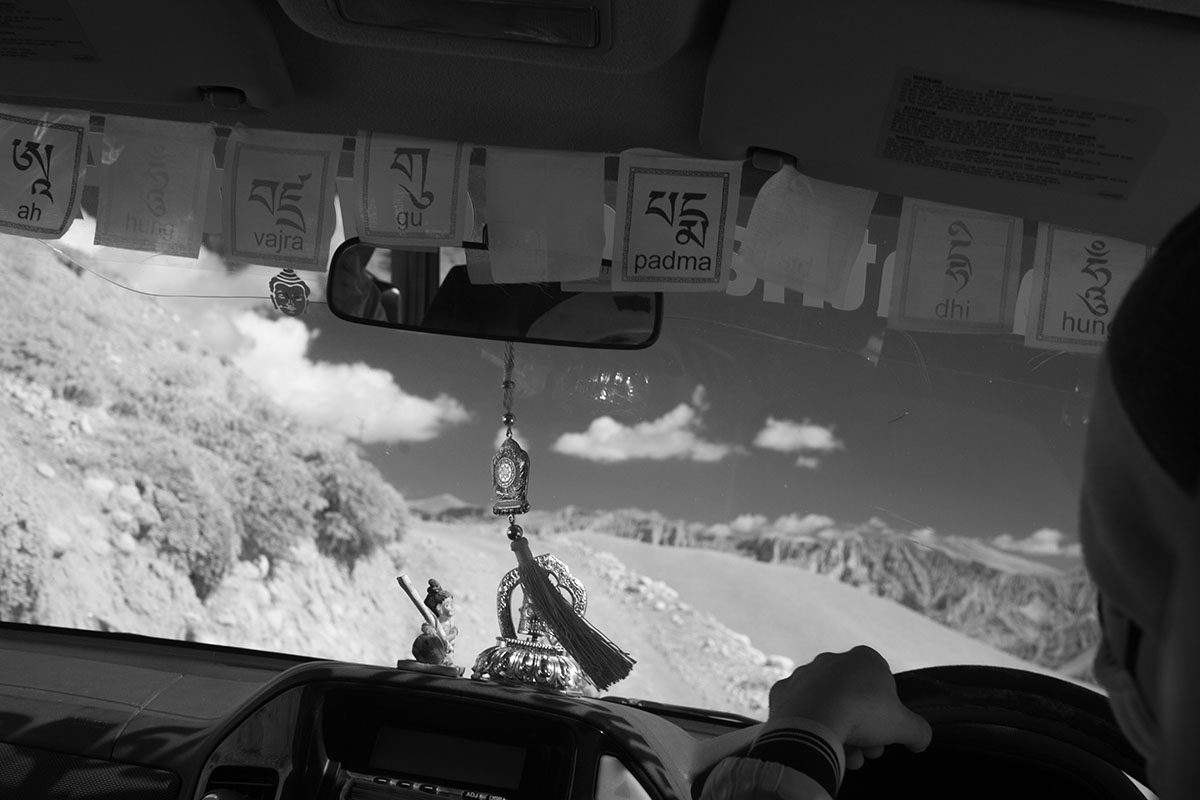
Mindful SUV We walked up to Lo Mang Tang, but hired a car to take us down the dusty road to Jomsen. This being a strongly Tibetan community the driver and owner have tricked the car out with appropriate Buddhist images and prayers, much like an Italian-American would have a St. Christopher medal hanging on the rear view mirror or a Kathmandu cabbie would have a figurine of the elephant god Ganesh on his dashboard.

Dendi Expounds I'm very pleased with this picture as I think it does a good job of showing the grandeur of Nepal's scenery as well as the intimacy of the trekking group. Only three of the people here are members of my group: My wife, listening, excellent guide Dendi Sherpa expounding, and the smiling young man, Santosh Rai, who carried my camera bag through so many thirteen and fourteen thousand foot passes. Even outside the group there is a certain intimacy to the trek as one spends time with and becomes familiar with the people headed in the same direction, whether other trekkers and their guides and porters, locals traveling, or commercial porters delivering supplies to high mountain communities. Note the guy on the cell phone! I had no coverage for most of this trip, but Nepal Telecom maintains an antique analogue CDMA network (which has better reach than digital GSM) that works when one isn't in the shadow of the cell usually at the apex of the passes, as here!
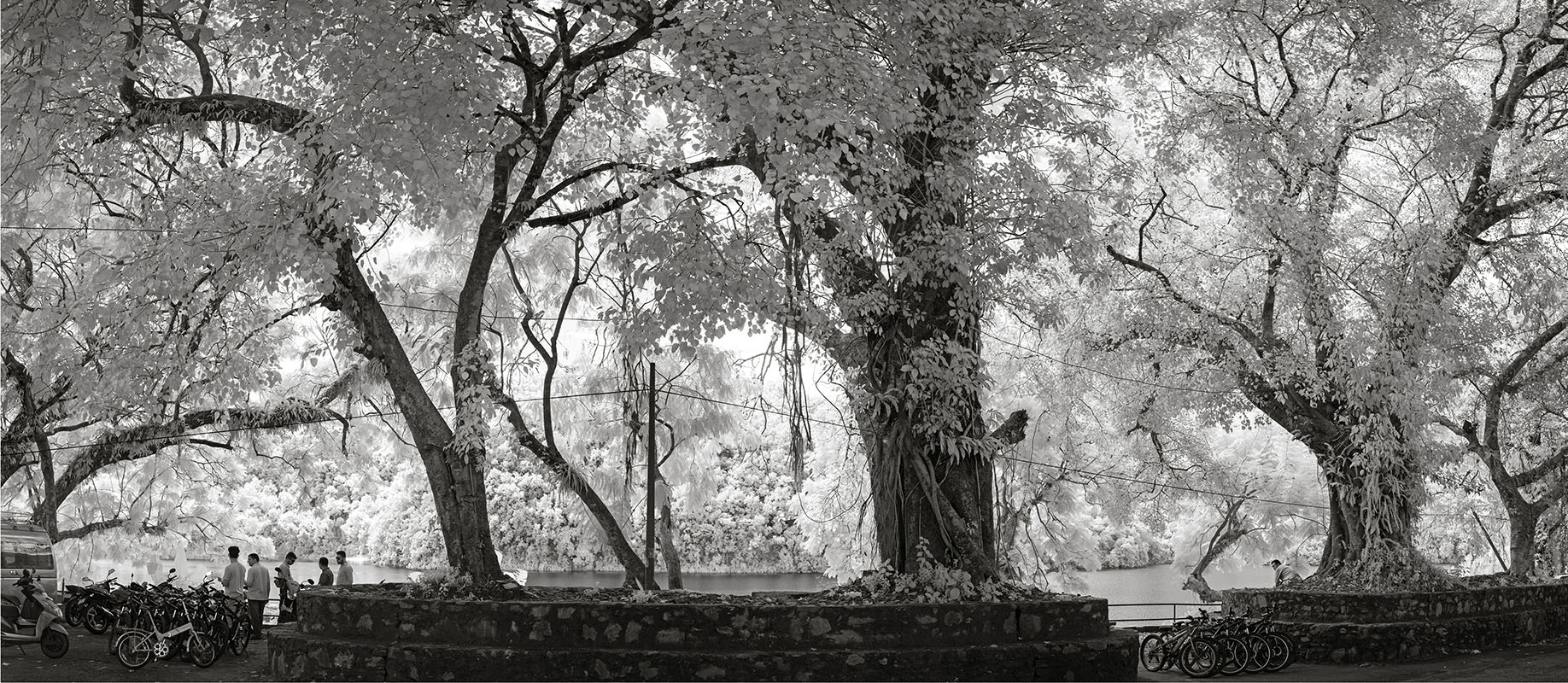
Fewa Lake, Pokhara I took this picture with my infrared camera on my first real visit to Pokhara, less than a year after I first set foot in Nepal, on a morning walk from the Glacier Hotel on the quieter southern end of Lakeside. One predictable aspect of infrared is that it healthy green vegetation comes out white. There's no snow, and no blossoms in this photo, but it does have a bit of a cold look to it, and some people have thought it had a Japanese look. No, really, it's very Nepali, very Pokhara, and it's a spot that anyone from Pokhara gets sentimental about since it's a pleasant quiet place people go to where they can chill, hang with their friends, where young people court. It's a stitched panorama, six individual overlapping photographs assembled in the computer in post-production. Not every photograph works in every size, but this one does. It looks great wall sized in the gallery, and I used it for my Christmas card a few years ago, and it looked really good small as well. It was also the image we used for the printed invitation to the show.
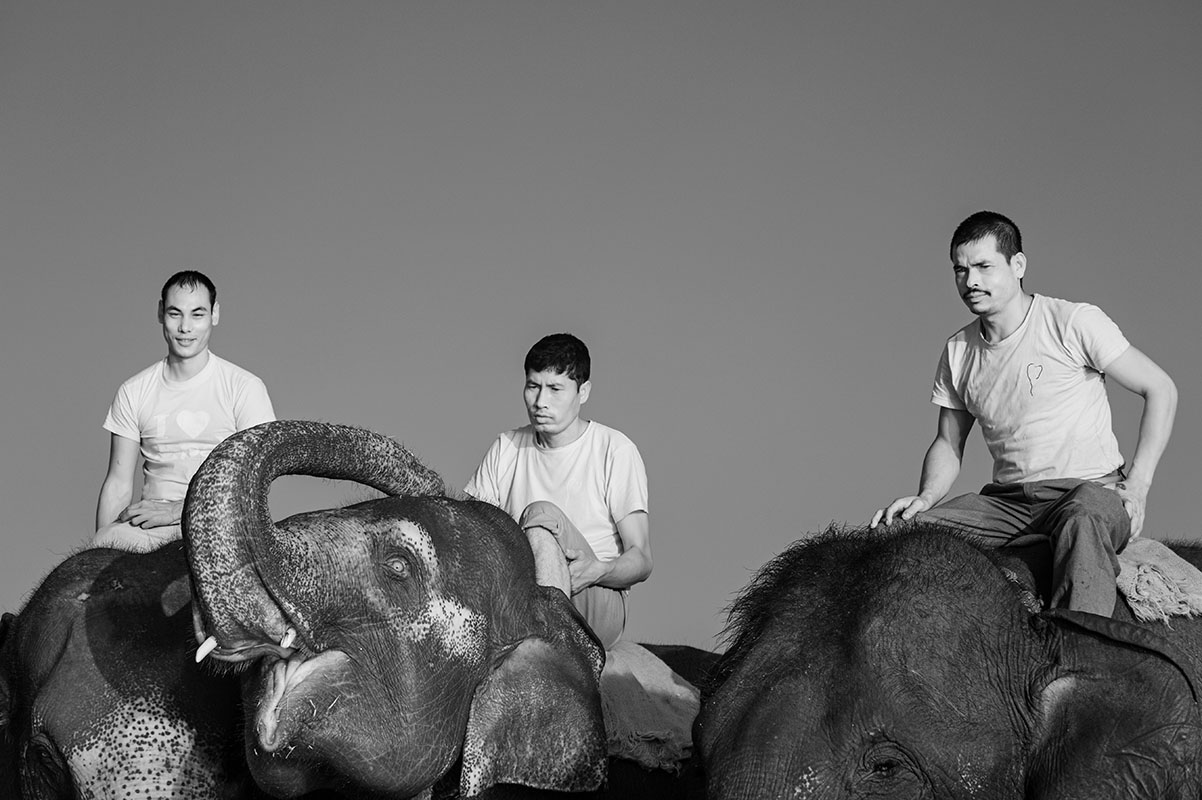
The Committee From the left to the right: Kishwar Tharu on Sita Kali; Dilip Mahato on Sandra Kali; Ram Charan Tharu on Saraswati Kali. Tiger Tops is a well established safari style resort on the edge of Chitwan National Park in the southern band of lowland Nepal known as the Terai. You might see a tiger there, but your chances are infinitely higher if you go to Bardia, another park, in February. Tiger Tops has a more than usual personal relationship with it's elephants and keeps them in larger paddocks, rather than chained, and (at least during the period I took this picture) did not put their guests on the elephants, but rather organized walks with the elephants. Much more personal and beyond cool! This picture was taken after walking with the elephants to the river for their afternoon bath. I think it does a good job of showing the bond between all the members of this team.
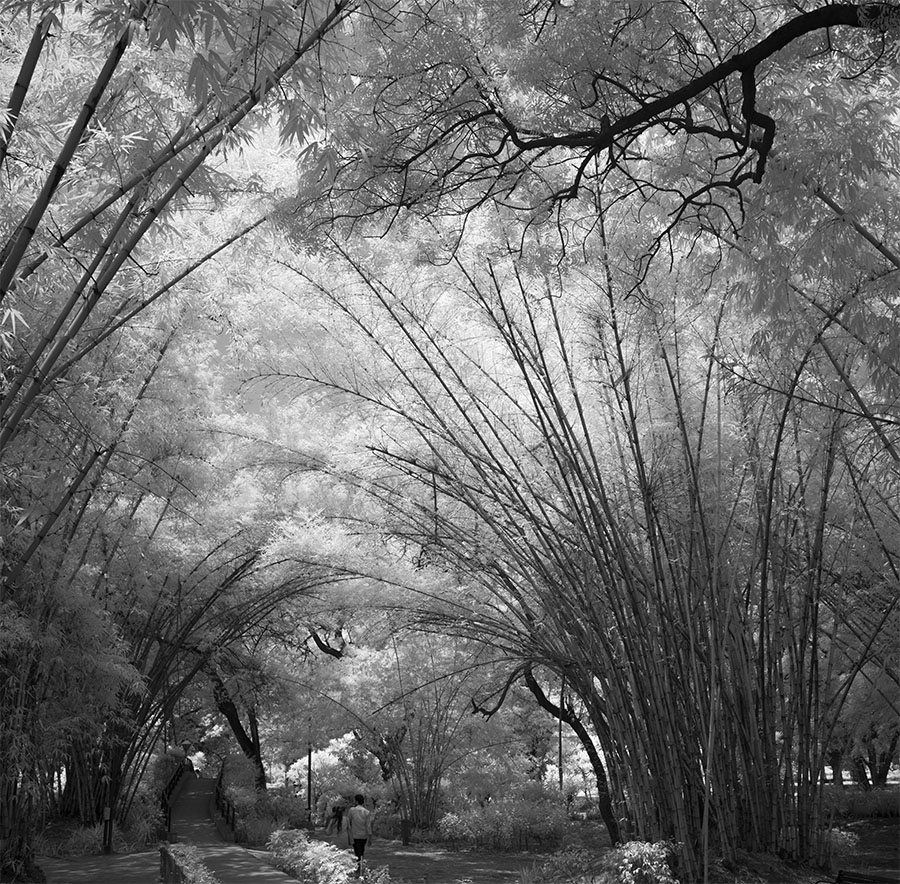
Lodi Gardens A city park in Delhi, built around a series of 15th century tombs and mosques. This is a two frame vertical panorama to compensate for the lack of a wide lens that day.
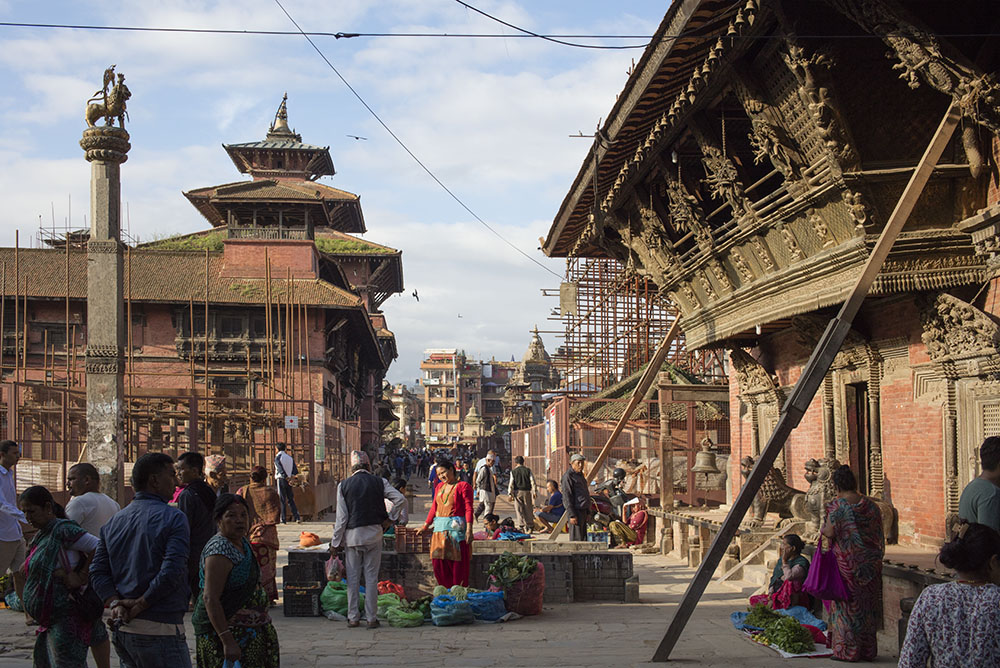
Patan Durbar Square This was my neighborhood in Nepal... I'm still amazed by the fact that this wonderful scene was only a couple of hundred meters from my own front door. It's Patan Durbar Square, a major international cultural site and a massive tourist draw that is also a critical and integral part of the neighborhood. Old guys hang on on the benches in front of the Malla palace in the afternoon, young people court on the bench in front of the Taleju Bell at all times of day. People sell vegetables in front of the Bhimsen Temple early in the morning, as you can see here.
I also like this because it's so very architectural, with an almost European renaissance feel (the Venetians especially were always doing wonderful pictures of public spaces) with the vanishing point of the perspective lines being emphasized by the face of the vegetable vendor in the middle ground.
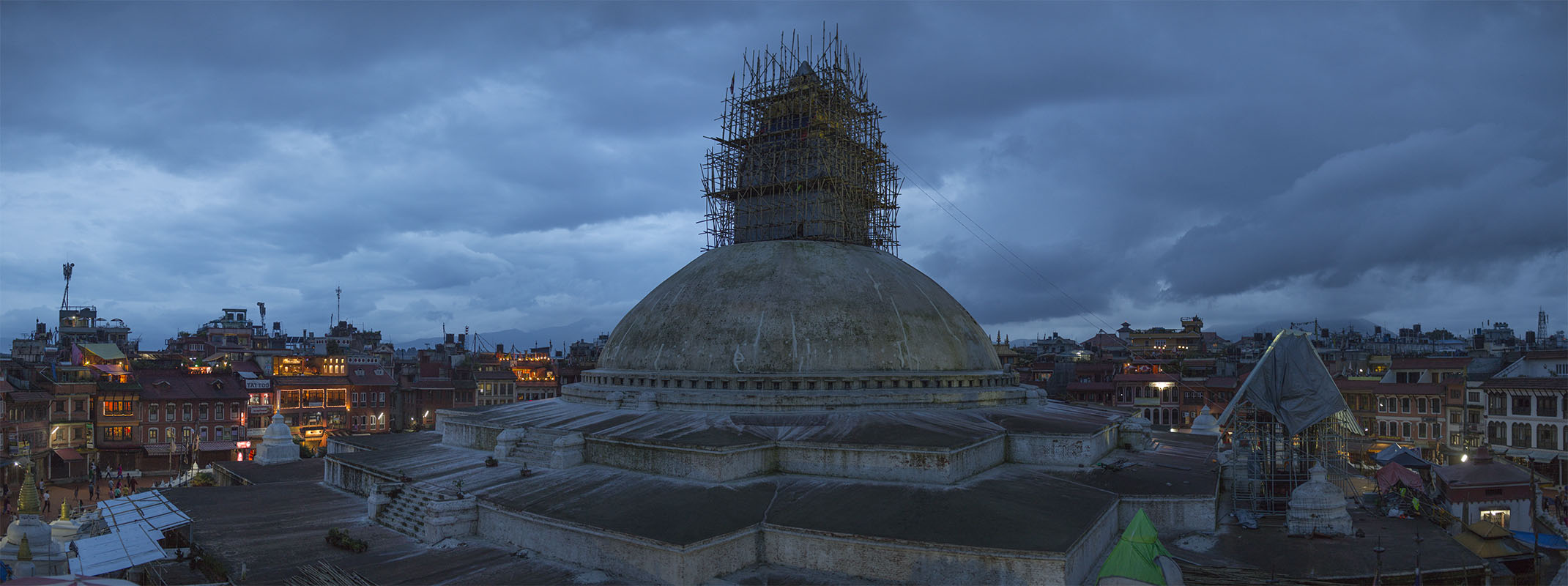
Boudhanath Under Repair, 2015 One of the three iconic temple complexes in Kathmandu. Pashuputinath is Hindu, and big pilgramage site for all Hindus, Swayambhunath is Buddhist, as is Boudhanath, which is also the center of Tibetan life and culture in Nepal. No one who lives in Kathmandu needs any introduction to this place, or it's odd intersection between what we westerners call the sacred and profane. It's holy, surrounded by monestaries and schools, peopled by pilgrims, but it's also surrounded by souvenir shops, tatoo parlors, bars, restaurants, and the best tapas joint in Nepal. Everyone seems to get along, helped, I suppose, by the fact that a person could easily move from the sacred to the profane in their own life, and back again. I took this picture in August 2015, less than a month after I arrived in Nepal, while I was in temporary housing in the neighborhood. The spire had been damaged by the earthquake earlier in the year and was being torn down to be rebuilt. The photograph is a stitched panorama, composed of six individual frames, all underexposed by a stop to ensure the moody blue sky came through.
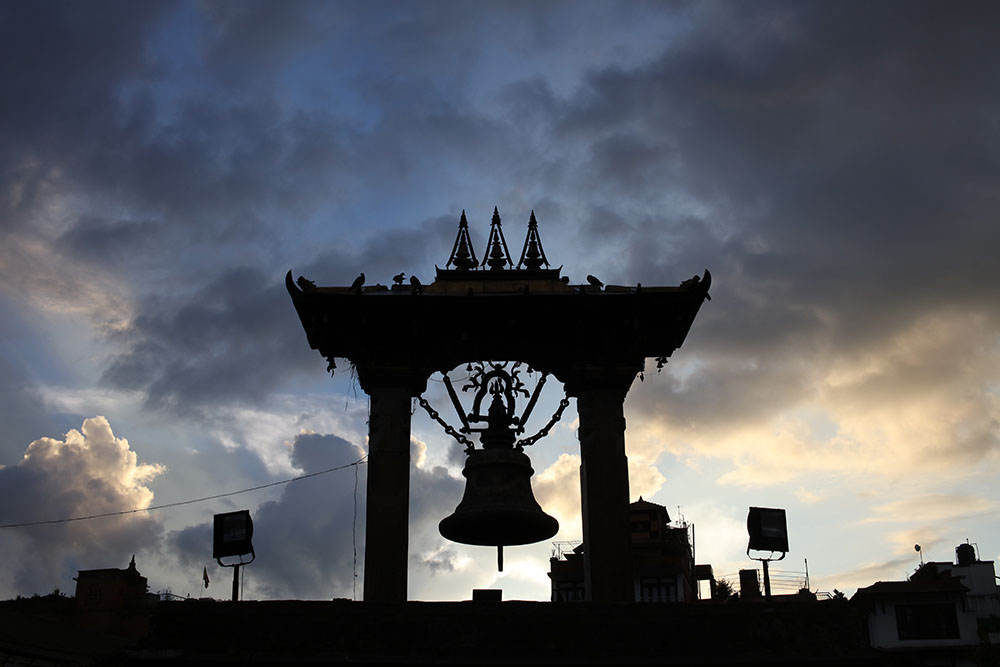
Teleju Bell Teleju was the tutelary goddess to the Malla kings of the Kathmandu Valley prior to the Ghorka conquest and remained important to the successor Shah kings. She is the goddess believed to the manifested in the Kumari, the "living goddesses" of Nepal. This big bell is sited outside the first door to the palace in Patan Durbar Square and was available for ringing when the king's subjects had an issue and wanted to talk to him. Unlike the other two pictures of the square in this show I took this picture in the evening, on my commute home.

Kathmandu Kite Kite flying is a seasonal thing in Nepal, something boys and men do in the fall, and so loosely associated with the festivals of Dasain and Tihar. As one looks over the cityscape of Kathmandu in the afternoon one can usually see a couple of dozen kites in the sky. There's only one here. These are South Asian fighting kites and the pilots compete to see who can cut the strings of their opponent's kites with the strings of their own kites. Perhaps this kite is the survivor of the afternoon's combat. The photo is a three frame stitched panorama.

Himalayan Valley This is Charang, a day's walk short of Lo Mang Tang. This panorama is made up of seven overlapping frames, and the very observant will notice that it overlaps the scene in Dendi Expounds. It's a big print and we sold it right off the wall. Normally in a gallery show a sold work will be marked, but stay on the wall until the show closes with the delivery or pickup afterwards. In this case it was clear that the sale wasn't going to happen unless the buyer could take it with him. What to do? Of course we took the only sensible route, took it down, rolled it up for him, and took his money! That left some blank wall... But I'd overprinted for the show and we hung the print below in it's place, which is why there are nineteen images here for a show that hung only eighteen prints.

Lo Mang Tang The capital of the Kingdom of Mustang, a small, walled, city in the high, dry, Himalaya. In the center of the city there is a small palace and a big heritage site Buddhist temple. It's a wonderful maze, photogenic and romantic. Like all of the little settlements in this area it's sited for access to water. There are little farms and orchards, but the city is built for defense, hence the wall.

Bell This photo was taken in Nuwakot on the way to Langtang Village on the year's anniversary of the 2015 Earthquake. Nuwakot was a little Newari Kingdom further up the Himalaya from the Kathmandu, captured by the Gorkha king Narayan Prithvi Shah before he took Kathmandu Valley itself and established what became Nepal. The hands belong to a Nepali Police Officer who accompanied us on the trek up the Langtang Valley and took special care of me, a weak, but determined, trekker.
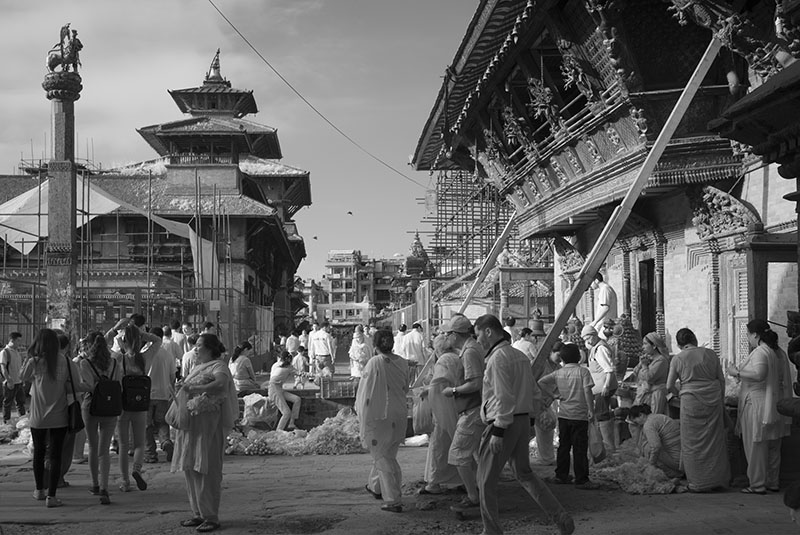
Patan Durbar Square This is the infrared companion piece to the color version above, and faced it in the gallery. I took it on the same morning commute as the other one, but a a bit less than a week later. There's a different group of vendors selling vegetables.
It was a great run, and when it closed, Sangeeta's daughter, Seetasma Thapa, pulled me in and pitched a small follow-on show at her venue, The Kathmandu Art Gallery, which was also a great run.